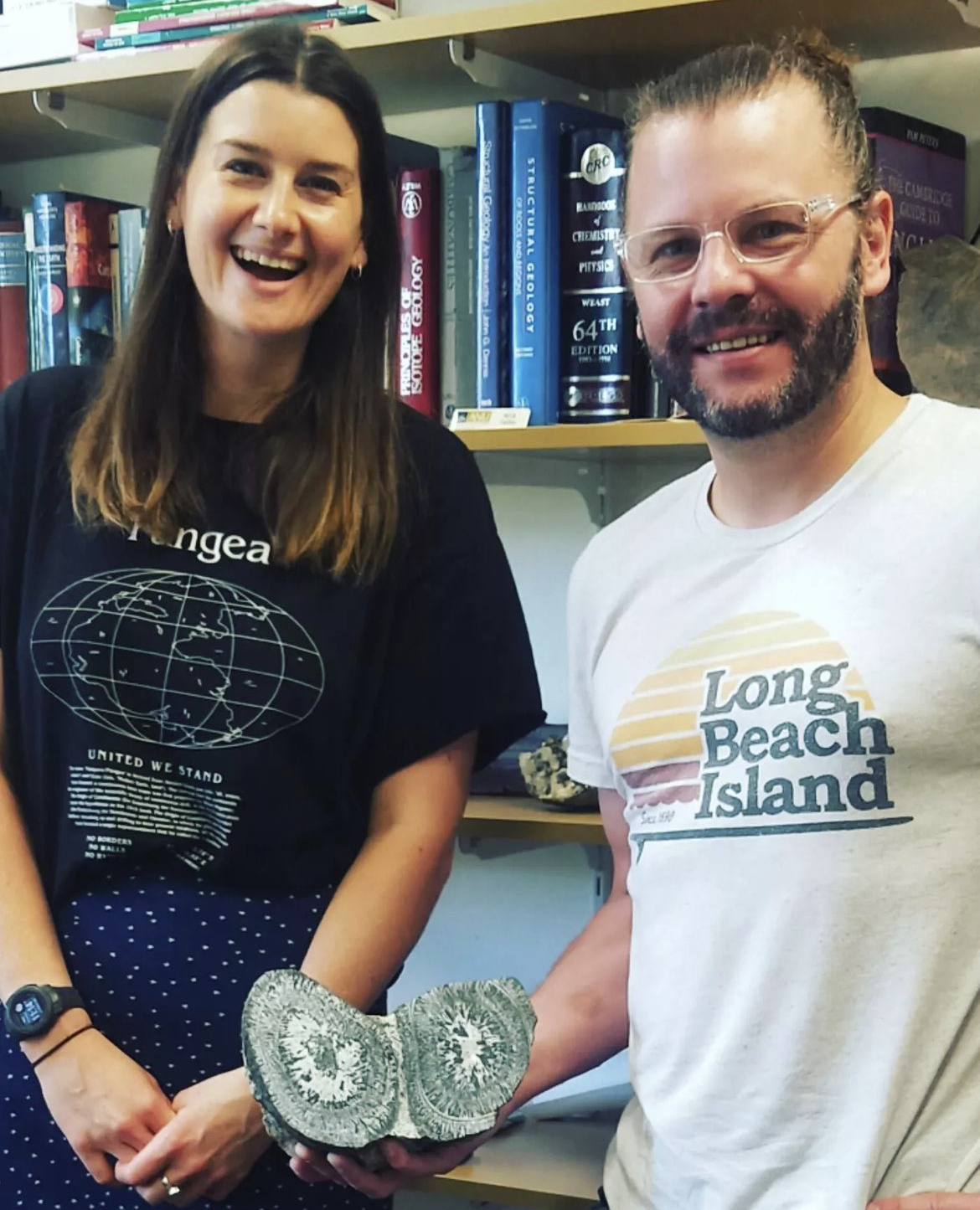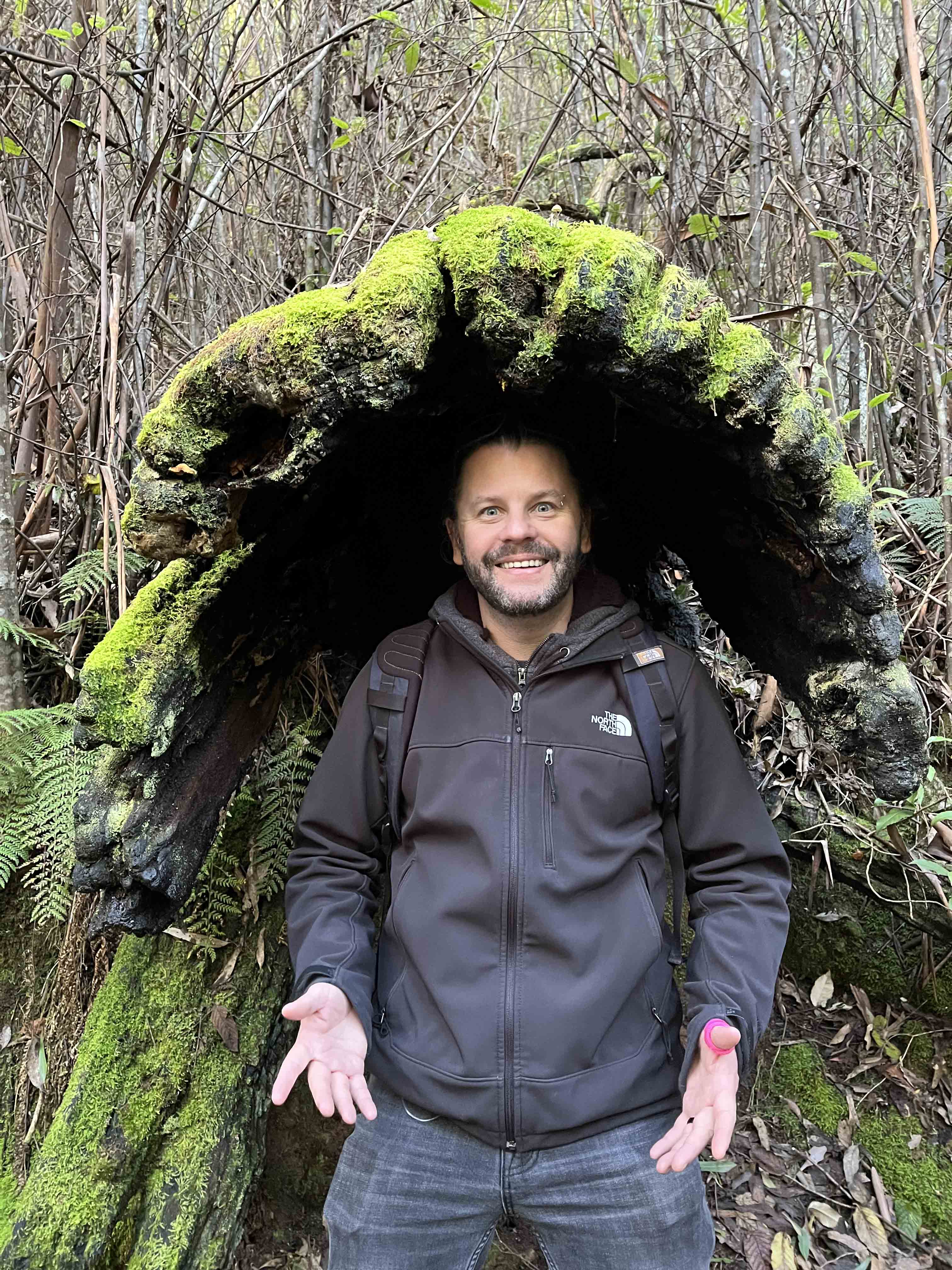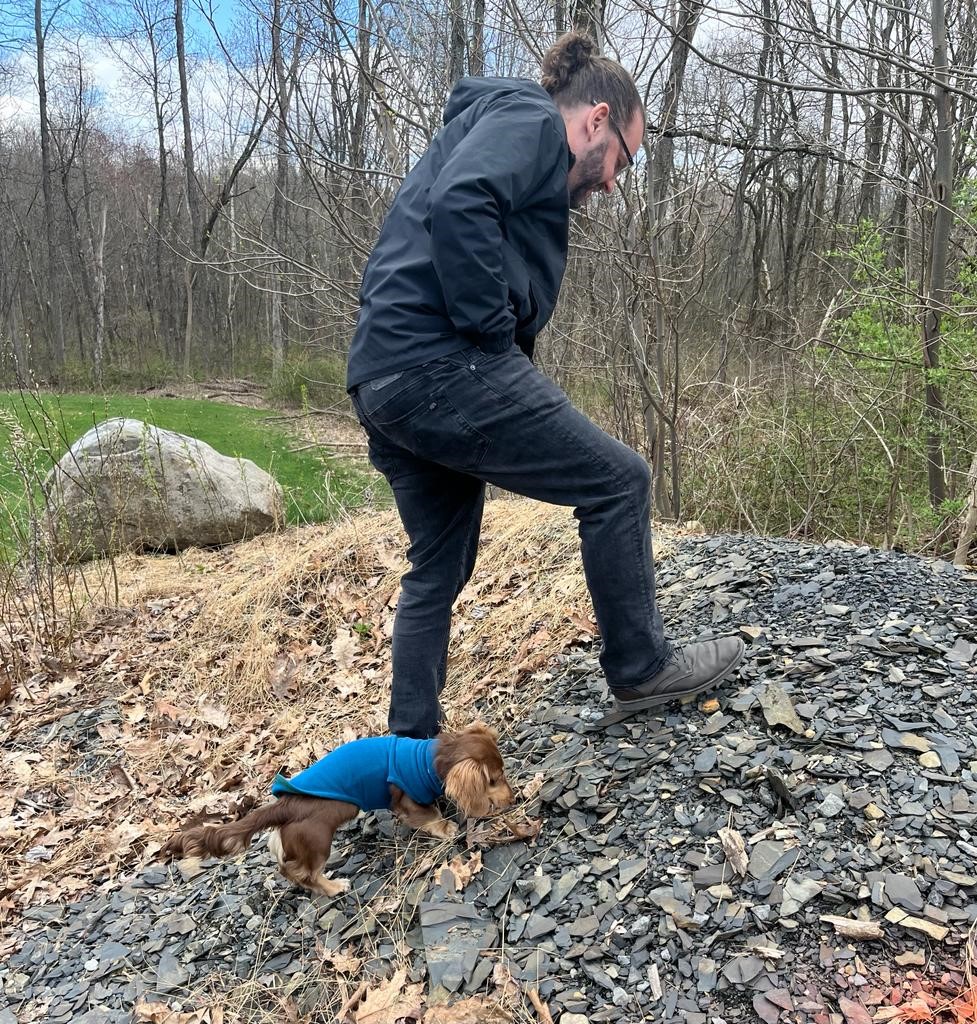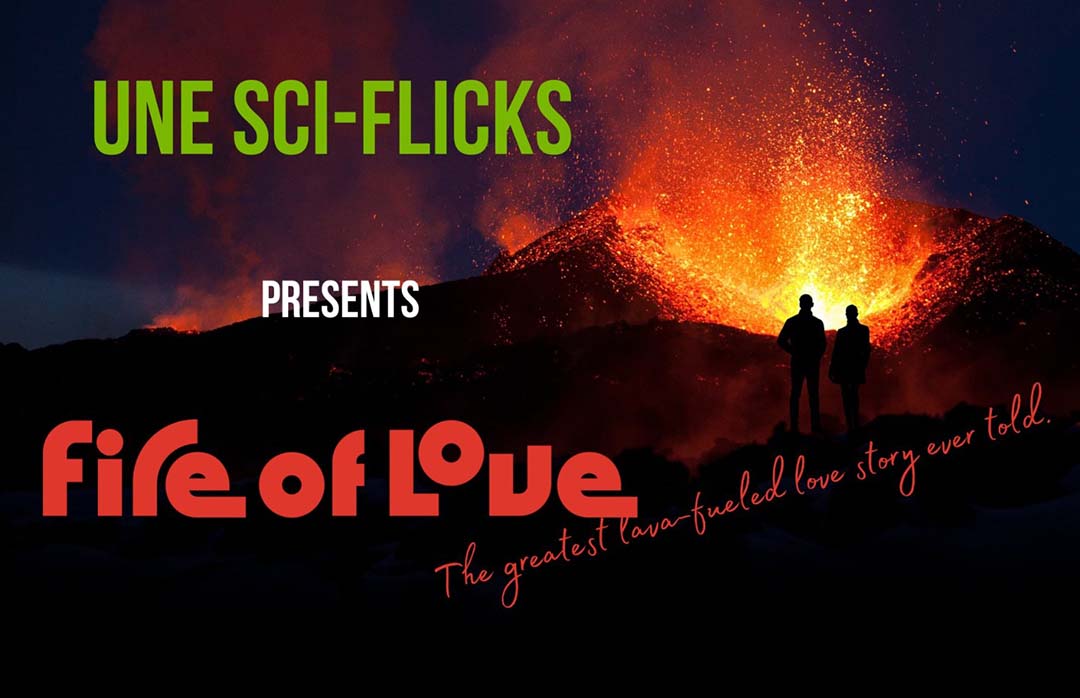This month's film, Fire of Love, is an explosive documentary that tells the fiery tale of two volcanologists who dedicated their lives – literally– to studying, photographing and filming volcanoes, leaving behind a legacy that would reshape our understanding of the earth for generations to come.
Ahead of the event, we had a chat with UNE Earth Scientist, Dr Nick Tailby, to talk volcanoes, eruptions, and the intrinsic role that passion plays in science.

Image: The brains behind UNE Sci Flicks, Dr Marissa Betts (left) with Dr Nick Tailby (right), who will be answering all of your volcanic questions this Thursday 9 February.
In the film, the Krafft's love of volcanoes was unfortunately their downfall; how dangerous is it to study volcanoes, and what is the likelihood of surviving an eruption?
Safety and risk analysis is probably the most important consideration when it comes to working on and studying active volcanoes. There are numerous risks working in and around volcanoes, the most obvious being the intense temperatures associated with a potential eruption. There are other risks too - volcanic bombs, lahars, mudslides, landslides and asphyxiation driven by volcanic gases. Tsunamis also pose a real threat, particularly in places like the island arc volcanoes we see around the Pacific. These are all things you need to assess when working in and around volcanoes.
The Kraffts' research and footage has become invaluable to volcanologists around the world. What can volcanoes tell us about the Earth, and our geological history?
I like to think of volcanoes as being big signposts that read something along the lines of, “you want to know how to make new crust and learn about what’s going on inside the Earth – look here”. There are a bunch of instruments and techniques we can use to study volcanoes. We can use their composition (isotopes or elements) to infer something about how/when/where they formed.
What makes a volcano more or less severe, and is there a way to tell an eruption is coming?
Severity is an interesting choice of phrase, so let’s run with it. There are many different types of volcano observed on Earth and the different types pose different sets of risks. There are entire textbooks devoted to our ability to describe the full range of compositions, textures and eruptive styles seen in nature. One metric by which scientists try to describe the severity of an eruption is the volcanic explosivity index (VEI), which is a log metric that scales from 0 to 8. As far as I am aware there have only been three of the most severe class of eruptions (VEI=8) in the last million years. These are extremely large eruptions that typically involve the collapse of a caldera, causing the rapid outpouring of magma and gas. While these types of eruptions are rare, they have potential to cause catastrophic amounts of damage. The other thing to note here is that we have only discussed the explosive danger of an eruption. There are many other reasons or phenomena that require us to closely monitor volcanoes, particularly in locations where they are spatially associated with population centers. Seismic events associated with magma movement can also cause landslides, tsunamis and mudslides that are equally dangerous.
In short, what volcanologists are generally trying to sniff out are moments in time where we notice change
In terms of predicting eruptions, there is no single smoking gun. Typically what scientists use is an array of different monitoring systems. This includes seismic arrays around the volcano and detailed topographic maps – these can be used to tell when magma has been ejected or moved. Another good way of monitoring the activity is to make measurements of the different gases emanating from the magma body – this is typically done by using infrared-based instruments. Other forms of monitoring include gravity and magnetic scans over the volcano, as well as scanning the acoustic properties of the volcano. By combing observations from multiple and independent instruments/techniques, this allows us to make the best predictions of an approaching eruption. In short, what volcanologists are generally trying to sniff out are moments in time where we notice change – say an increase in seismic activity, in conjunction with a change in gas composition and the overall shape of a volcano.
Not only does the film portray the epic love story between Maurice and Katia Krafft, but it also visually represents the love and dedication that many scientists have for their discipline. How important is passion when it comes to science? What would be your advice to someone wanting to pursue their passion for geology?
It certainly doesn’t hurt to have a lot of passion, particularly if that passion can be focused on a specific set of research goals. My advice, for what it’s worth, is to explore the literature and communicate with other scientists without the fear of the unknown. Everyone in science has to start somewhere. Most of my research programs don’t come randomly out of the blue, but they come rather organically from the “isn’t that weird” moments. These kinds of moments are genuinely coaxed along from discussions I have with other scientists and researchers. So in summary, be open to discussion/communication.
What is your favourite thing about volcanoes? 
Volcanoes are basically the end-product of numerous processes that occur within the planet.The magmas emanating from volcanoes, or lavas, represent a window into the inner workings of the Earth. In my line of research we tend to focus on zoning observed in minerals found in eruption products (think tuffs and ignimbrites – basically thick and extensive debris flows that come from large scale eruptions), particularly among minerals that some people are familiar with – quartz, zircon and (possibly new to you) pyroxene. The chemistry and zonation observed in these minerals can help us deduce things like age (i.e., when did the minerals crystallise from the magma), how hot the magma got prior to eruption, what triggered the eruption, and the timescale involved in the whole melt generation-eruption cycle. Understanding and defining these processes in volcanic environments from the past (and New England has some spectacular examples of large-scale eruptions during the Permian), particularly among the large-scale eruptions (or high VEI as we learned earlier) allows us to make predictions about places where future eruptions are likely (places like Indonesia, New Zealand, the Pacific northwest of the USA, etc).
Tell us a bit about your background, and what sparked your interest in geology?
I originally hail from Melbourne, and I have spent about half my life in the USA (mainly in New York) and about half here in Australia. I did my PhD at the Australian National University, then was lucky enough to do a NASA funded postdoc in New York (Rensselaer Polytechnic Institute). After that I joined the department of Earth and Planetary Sciences at the American Museum of Natural History as a Research Fellow. If I had to describe my research – I use a combination of experiments and observations made from natural rocks/minerals in order to determine information about minerals record formation conditions. This includes themes like crystallization temperature, pressure, oxygen pressure and temporal rates of change.
I’m not particularly interested in the prettiest or the most valuable rocks; what makes me excited in my job are the rocks that tell a story.
It's hard for me to pinpoint exactly when I discovered Earth Science, but I’d guess it was probably in first year at uni. If I had to describe what drives my research, I’m not particularly interested in the prettiest or the most valuable rocks; what makes me excited in my job are the rocks that tell a story. That’s basically what I’ve been doing ever since going to graduate school, trying to develop new tools in rocks and minerals that geologists can use to help interpret something of environmental conditions.
If you had to choose one volcano from any time period, which one fascinates you most and why?
Like children or pets, we geologists try not to have favourites – so let me take the question and tweak it ever so slightly. There are two volcanic eruptions I am currently working on – and I find them equally fascinating:
- The Canowindra volcanics – the rocks situated between Canowindra and Cowra represent a neat cross-section through an ancient volcanic system. In this system you can see the magma chamber at depth (near Cowra), with a whole bunch of country rock that got entrained in, and was physically and chemically reacting with, the magma body. Then to the north (around Canowindra) you have a fairly large stack of ignimbrites (essentially the eruptive ash cloud). I like this location because it basically shows you all the inner and outer workings of a complex volcanic system. Basically, had you been around Canowindra 432 million years ago, you would have had one very crazy day.
- Mare basalts from Apollo 11, 14 and 15 – When we talk about volcanoes, we tend to think mostly about the Earth. But the other terrestrial bodies (the Moon, Mars, Mercury, Vesta, etc) where (at least at some point in time) volcanically active. The lunar basalts are amazing to look at – they look as fresh as something you collected from an active volcano, despite being billions of years old. Basically the Moon has no atmosphere or weathering cycle, so the rocks still look very pristine. It’s also remarkable to look at something that was literally collected by Armstrong and Aldrin – that’s not something you see every day.
You have only recently started your new position here at UNE. Can you tell us a little bit about your role, why you were drawn to UNE's Earth Science department, and what you are excited to sink your teeth into this year?
The current department are young, talented and excellent group of researchers who genuinely care about how the Earth Sciences can contribute the needs of broader Australian community.
 When I left Australia 13 years ago, I did so with the understanding that I wanted to learn from scientists outside the Australian system – basically I found myself thinking and answering question much like my PhD advisors. By moving overseas I hoped to learn how other people in other places and in other systems approached and valued science. And it’s not just about the science, I really learned a lot about yourself by moving to another country.
When I left Australia 13 years ago, I did so with the understanding that I wanted to learn from scientists outside the Australian system – basically I found myself thinking and answering question much like my PhD advisors. By moving overseas I hoped to learn how other people in other places and in other systems approached and valued science. And it’s not just about the science, I really learned a lot about yourself by moving to another country.
Moving back to work at UNE was any easy decision for my wife and I, the department has a long and rich history of producing world class Earth Scientists. The current department are young, talented and excellent group of researchers who genuinely care about how the Earth Sciences can contribute the needs of broader Australian community.
So,in a nutshell, I wanted to contribute back to the system that got me excited about Science, but also help train a younger generation of scientists and provide them with the tools they can use to help plan for the future.
In terms of sinking my teeth into things – I’m still pretty green, but I have basically spent the first few weeks trying to (a) build up my knowledge of the courses we teach here at UNE, (b) get to know the local geology (I’ve been kicking around a lot of new rocks), and (c) getting a sense for the type or research people here at UNE and the professional geologist in NSW/Australia are excited about. I’ve got some irons in the fire regarding research – so “watch this space” for things down the track.
Lastly, what is the one thing you hope people take away from the film?
The thing I took away from the documentary is that it’s a pretty special thing to be able to do what you love, and the whole experience is probably made richer if you get to do it with the person you love most in the world.
Sci Flicks Key details:
WHEN: Thursday 9 February, 6pm
WHERE: Belgrave Twin Cinema, Armidale
TICKETS: Tickets are $10, and can be purchased here. Themed cocktails will also be available for purchase on the night.


